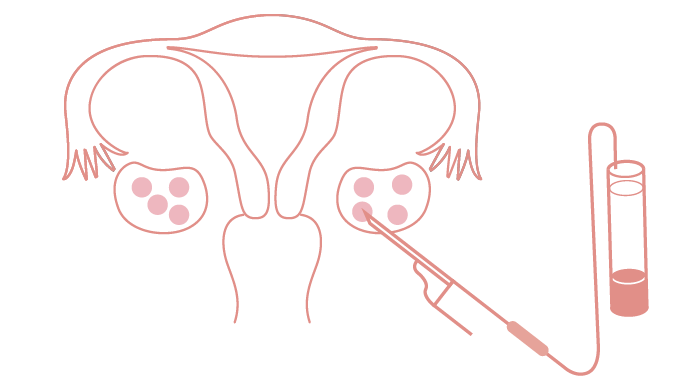Egg freezing
Egg freezing extends your biological clock – your timeline for deciding if and when you become a parent – by preserving your fertility potential today. Olive Fertility has a state-of-the-art lab and award-winning lab team with extensive experience in all aspects of egg freezing.

The procedure involves stimulating your ovaries to make multiple eggs, retrieving the eggs from your ovaries, and flash freezing them in a lab. Your eggs can then be kept frozen in storage and thawed at a later date when you are ready to become a parent.
The good news is that if you decide to have IVF with your frozen younger eggs when you are in your 40’s, your chance of success will be the same as if you were still in your 30’s.
Find Out Your Chances of Conceiving
Olive Fertility has designed an online calculator for you to determine your likely success for pregnancy through IVF based on the number of eggs you have frozen.
Please choose an age between 25 and 44
Age:
Learn More About the Process
Start by Empowering Yourself with Knowledge
While fertility experts identify age 35 as when a person’s fertility starts to rapidly decline, the fact is we are all unique and, in some individuals, their egg quantity declines sooner or later than others. So, if you are considering egg freezing, it is important to have a complete fertility assessment with a fertility specialist.
How to Get Started
Your consultation and most of your testing is covered by MSP if you have a referral from a qualified provider to Olive.
Qualified provider types who may refer to Olive Fertility include:
- your family doctor
- a family physician at a walk-in clinic
- a family physician via the Telus Health MyCare app
Once Olive receives the referral, a patient care coordinator will contact you and send you a list of the tests you need to take before your first appointment. This includes a simple blood test that indicates your ovarian reserve and the number of eggs you will likely get from an egg retrieval. The tests:
- FSH (follicle stimulating hormone)
- AMH (anti Mullerian Hormone) test
Your Initial Consult
At your consultation, your Olive doctor will discuss your goals, review the results of your tests, talk about what you can expect through the egg freezing process, and go over your options. You will be able to ask any questions that you have.
Transvaginal Ultrasound
Your Olive doctor might also provide a transvaginal ultrasound or sonogram to check your ovarian reserve and the health of your ovaries. This procedure is performed by inserting an ultrasound probe internally, allowing your physician to see problems like cysts on the ovaries and fibroids on the uterus. In addition, your physician can assess your ovarian reserve by counting the small follicles in the ovaries that contain the immature eggs
Your Orientation
When you decide to freeze your eggs, you will then meet with your care team nurse for a detailed orientation where she will discuss what to expect in the process, your treatment schedule, and how to take your medication. You will then start your egg freezing process.
How Egg Freezing Works: Vitrification, New Reproductive Fertility Preservation Procedure in Canada

Alternatives to Egg Freezing
If there are reasons you and your doctor decide that egg freezing is not right for you, then you might consider other options: like getting pregnant immediately, fertilizing your egg and freezing the embryos, or donor eggs. These options depend on your eggs, your test results, and your life circumstances. Every person is different, and Olive is dedicated to helping you decide on the plan that is right for you.
Next: The Egg Freezing Process
The Egg Freezing Process
Your egg freezing process can comprise of up to 4 phases.
Priming
Priming involves using medication that ensures your eggs are in a healthy environment and are all at the same stage of development when we stimulate them.
Stimulation
The next phase of your cycle is called the stimulation (stim) phase. Your doctor will create a cycle plan that is suited to your fertility needs. During ovarian stimulation, you will take injections that cause your ovaries to grow multiple follicles. Each follicle contains one egg. The goal of the stimulation phase is to grow as many follicles as possible in order to retrieve mature eggs. Your nurse will tell you when to start injections.
Most individuals need 10 -12 days of stimulation injections, although some take longer before the follicles are ready for egg retrieval.
Egg Retrieval
Egg retrieval is a procedure that involves removing the mature eggs by passing an ultrasound probe into your vagina. Alongside the probe we pass a needle that gently enters the ovary and suctions out the eggs. The procedure is mildly uncomfortable. Before the procedure, you will be given an intravenous pain medication and some freezing medication in your vagina to minimize any discomfort you might feel.

The retrieval is a short 15 minute procedure at the Olive clinic.
Vitrification
After the retrieval, your eggs are flash frozen and stored for future use. Olive uses an egg freezing procedure called vitrification which ensures eggs are not damaged as they are frozen and, when thawed, see IVF success rates that are the same as for fresh eggs.
Violet™ AI-Powered Egg Assessment
Violet is an AI-powered tool that helps patients gain insight into the quality of the individual eggs they are freezing. Violet offers a more personalized knowledge base where, instead of determining a patient’s chances of conceiving based on age and egg number, every patient, every cycle, and every egg can be considered independently.
With Violet, the Olive embryologist will take photos of each of your eggs. Using computer vision and AI, the likelihood of each egg successfully fertilizing and becoming a blastocyst is calculated using an algorithm based on hundreds of thousands of images in the training data set to assess the probability of each individual egg developing into a healthy embryo and resulting in live birth.
Your doctor will review your Violet report with you during your follow-up consultation. You can use this insight to make an informed decision about whether to do another egg freezing cycle and, if so, how to tailor the next cycle to optimize outcomes.
Next: Storage & Using Your Eggs
Storage & Using Your Eggs
Egg Storage
Your eggs will be safely stored at CAN-Pacific Cryostorage -- a new state-of-the-art long term storage facility that provides a safe and secure storage option for Embryos, Oocytes (eggs) and Sperm samples from IVF centres in Western Canada. CAN-Pacific offer 24/7 video surveillance, an alarm system and motion detectors.
Each storage tank has its own separate monitor in place to ensure proper tank temperature and liquid nitrogen levels, as well as automated and manual monitoring of these levels by experienced personnel. CAN-Pacific Cryo is protected against power failures, or any other interruption, with backup generators and adequate on-site liquid nitrogen supply. With multiple levels of monitoring and redundancy, CAN-Pacific Cryo’s goal is to provide the safest storage environment possible.
When You are Ready to Use Your Eggs
Your eggs can remain frozen for an indefinite period of time until you are ready to conceive. Once you decide to attempt a pregnancy, you will go through a regular IVF procedure. This involves carefully thawing the eggs and fertilizing them with sperm in a lab. A fertilized egg is called an embryo.
The embryos are grown in an incubator for several days (usually three to five days), and then one will be transferred into your uterus. Any extra embryos can be frozen for use at a later time.
Financial Considerations
The Olive Fertility accounting team would be happy to help you with questions on costs associated with treatment and storage. Our aim is to provide you with all the information you need to make this part of your treatment go as smoothly as possible. Visit our Price Guide for details on costs.
Ready To Get Started?

Let's make it easy for you to book your first consultation. Click below to learn the steps.
Learn More about this Topic
Olive clinic experts have shared helpful insights on the Olive blog. Check out the following quick reads to learn more.

